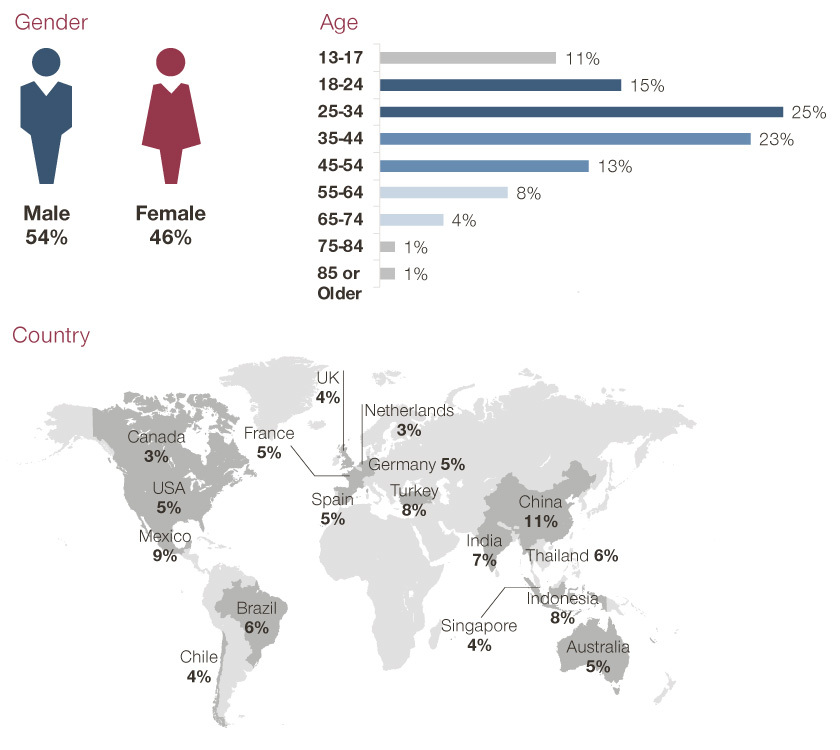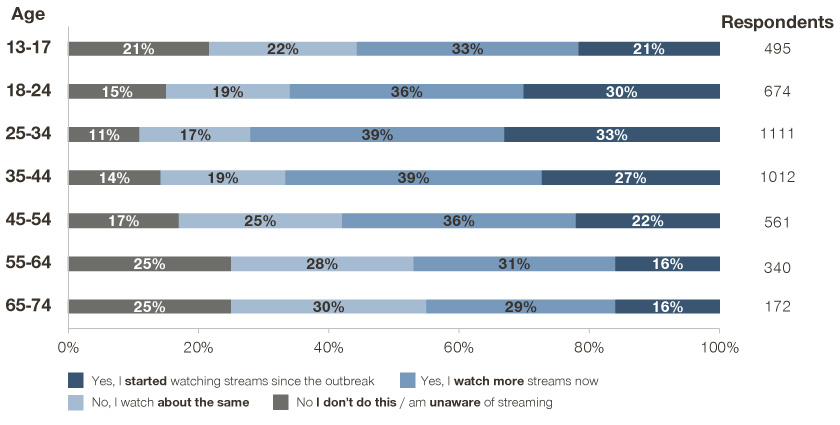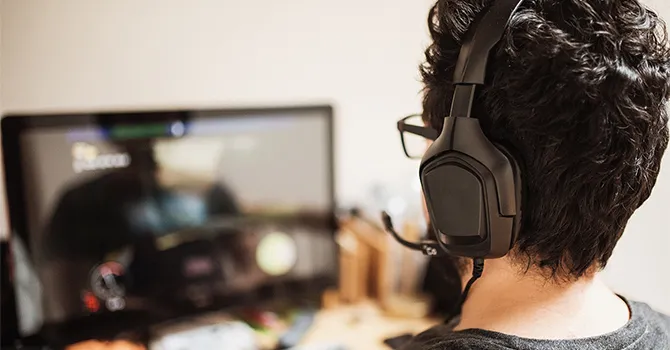*The insights and recommendations shared in this article are based on the circumstances as of August 26, 2020
Gaming is one of the few growth industries during COVID-19. Our most recent study found a permanent 21 percent increase in monthly spend by gamers, a 11 percent increase in time spent gaming, and a 42 percent increase in video game streaming. This means the industry will outperform expectations in 2020 and beyond. Successful publishers will need strong acquisition, monetization, and retention strategies or else risk underperformance.
Though COVID-19 still has a firm grip on the planet, some industries are seeing growth, in particular the gaming industry. Prior to COVID, experts forecasted that 2020’s global games market will generate revenues of 159.3 billion US dollars, a healthy year-on-year growth of 9.3 percent. In addition, they expect the market will exceed 200 billion US dollars by the end of 2023. This almost doubles the growth rate of 5 percent seen between 2018 and 2019.
How does this come about? Our newest study about the impacts of COVID-19 on the gaming industry shows that lockdowns have accelerated existing trends, created new trends, and caused structural changes in behaviors, which are all expected to continue post-lockdown. What can game publishers do to ensure they capitalize on these trends, now, and in the future?
Simon-Kucher Global Gaming Study: Impacts of COVID-19 analyzes gamers’ behaviors
The above mentioned industry growth is not surprising, as consumers are unable to spend as much time outside, or with friends and family, and thus are looking for indoor entertainment, ways to escape the news cycle, and new socialization options. Our study set out to understand the reasons behind this growth: In what ways have consumer behaviors actually changed? How much more money and/or time are they spending? And most importantly, will these trends last? In May and June of 2020, Simon-Kucher conducted the Global Gaming Study: Impacts of COVID-19, surveying more than 13,000 representative consumers across the world, identifying nearly 5,000 gamers and ask them these questions.

Our study identified two key effects the pandemic has had on gaming:
- A lasting increase in money and time spent on gaming, and
- A shift in what types of games are being played (more multiplayer games) and how gaming content is being consumed (more video game streaming).
Whether publishers can take advantage of these trends will be a determining factor in their under- or over-performance versus the industry.
Gamers invest more time and money
Our study showed that globally, there was a 39 percent increase in the amount of money consumers spent monthly on games during May and June versus pre-COVID-19. This trend was consistent across almost all age groups. And what’s more, respondents indicated this was not temporary: Spend is expected to stay elevated at 21 percent compared to pre-pandemic rates.
People not only invested more money, they also were ready to spend more time. In our study, we categorized participants into four types:
- non-gamers (playing less than one hour per week)
- casual gamers (playing between one and five hours per week)
- gamers (playing between five and 20 hours a week)
- serious gamers (playing more than 20 hours a week)
Our study saw a huge shift from the lower towards the higher categories; during May and June, 17 percent of non-gamers and casual-gamers became gamers or serious gamers. Amongst all gamers, the number of gamers and serious gamers went from 49 percent to 64 percent, and is expected to permanently settle at 58 percent.
With gamers increasing the time and money spent on gaming, publishers who are able to effectively align their acquisition, monetization, and retention strategies are most likely to reap the benefits. More precisely, game publishers need to start thinking of more creative ways to capture the increased amount of value gamers are deriving from the time they spend playing. In an environment where gamers are playing more and willing to spend more, the most obvious beneficiaries are those publishers that best utilize microtransactions and subscriptions to monetize this usage.
But this doesn’t necessarily mean every publisher should start using microtransactions and subscriptions. They rather need to consider their customers’ lifecycle strategy holistically, as this will determine the success of these monetization strategies.
Our advice: Publishers will be the most successful if they manage not only to monetize gamers’ increase in time spent (i.e. through microtransactions and subscription services), but also ensure they have strong acquisition and retention strategies to keep gamers engaged long enough to turn them from players into payers.
Positive and negative example: Epic Games’ Fortnite excels in all three areas. It is a free-to-play game (driving acquisition), which leverages a large variety of microtransactions including seasonal “Battlepass” subscription offers (driving monetization), and is constantly releasing new content that re-engages players and has social functionality (driving retention). This formula has worked exceptionally well and brought in around $4B, making it one of the biggest revenue-generating games in the world.
By contrast, EA’s Rocket Arena is an example where the acquisition strategy initially failed. A clear Battle Royale style game, it has a focus on microtransactions but is not free-to-play. Originally priced at $29.99, it dropped to $5 within two weeks due to too few gamers signing up. EA failed to identify if customers would be willing to pay the up-front cost, given the competitive landscape, and thus did not balance monetization mechanisms correctly. To avoid a mistake like this, a customer research study could have identified what monetization strategies make sense for target audiences.
Gamers are seeking more social games
Our study found that consumers not only played more, they also played differently. The majority of all gamers surveyed (60 percent) said they are playing different game types during lockdown, with a majority (60 percent) stating they are playing more multiplayer games, and specifically game types with social components.
The survey respondents showed the biggest increases in Multiplayer Online Battle Arena games (MOBA), like League of Legends, and Battle Royale games, such as Fortnite. Both types of games have heavy social and communication components. Though this is not a new trend (games have been refining their social communication capabilities for years), the normalization that the pandemic has created around virtual communication is likely to make this a bigger differentiator for developers moving forward, with those that execute well, likely to be more successful.
Our advice: Given the trends we saw toward social games, publishers with native communication capabilities, which make it easy and enjoyable for people to interact, will be able to better drive virality, lock gamers to their platform, and thus acquire and retain better gamers of all types. Further monetization can be done by connecting gamers in ways that drives microtransactions, through utilizing behavioral psychology. An example we have seen work for some games is to pair players with high spend on visible premium items with low spend players, to create a desire to emulate the higher spend players.
Streaming is now mainstream
However, not all publishers will have the luxury of multi-player and social components in their games to increase monetization. We also detected another accelerating trend that works for publishers of all types of games, including single player: video game streaming.
Streaming has become a massive component of the gaming world with the majority (81 percent) of survey respondents stating they are watching more gaming streams during lockdowns than before. Not only that, our study showed that 23 percent of respondents began to stream for the first time during the pandemic. Twitch, one of the foremost videogame streaming platforms, gives further evidence to this: Users watched five billion hours in total from April to June 2020, an increase of 63 percent from the first quarter. Interestingly, the biggest group of streaming users in our study was the age group 25-44, rather than younger teens often associated with the trend.

Our advice: As video game streaming becomes further integrated into gaming culture, we advise publishers to offer direct, interactive streaming bundled into games so viewers can participate and do more than just cheer on their favorite players. Ubisoft is dipping their toes into this concept with Hyper Scape and a Twitch extension, letting gamers directly interact in new and creative ways. This becomes a whole new area for companies to acquire, monetize, and retain gamers on single player games as this adds community/social elements, without changing the core game mechanic.
Game publishers: How to profit from these behavioral changes
There are a couple of key concepts game publishers will need to keep in mind benefit from the ongoing development:
- Acquisition: As demand grows, so do the competitors trying to take their share. What are gamers looking for? What do they value? And how can you highlight this in your communication? What makes you any different from the next game? What is the trade-off between different monetization models in customer lifetime value? What is the optimal acquisition strategy for Customer-Life-Time-Value? Being able to answer those questions will help you acquire the ever growing base of gamers.
- Monetization: An effective way to monetize gamers both now and post-pandemic will be important in maintaining strong growth. Given the strong feelings gamers have around how they are monetized, creativity coupled with deep customer insight on needs and preferences promises the best results. Understanding the right way to charge is much more important that what you are charging, and executing it effectively can be the difference between success and failure.
- Retention: As the demand begins to settle, ensuring gamers keep playing your game will be crucial, whether that’s through community/network effects or by constantly re-engaging content. Do not underestimate how social features, whether in-game or via streaming platforms, will be important for gamers' choices in the future, and build your capabilities and strategies now rather than offering too little, too late.
Balancing these elements of acquisition, monetization, and retention is what we see as the driving force behind the future leaders of the gaming industry.
To receive the complete study report, please reach out to the authors.
Read about other aspects in our Global Gaming Study:








